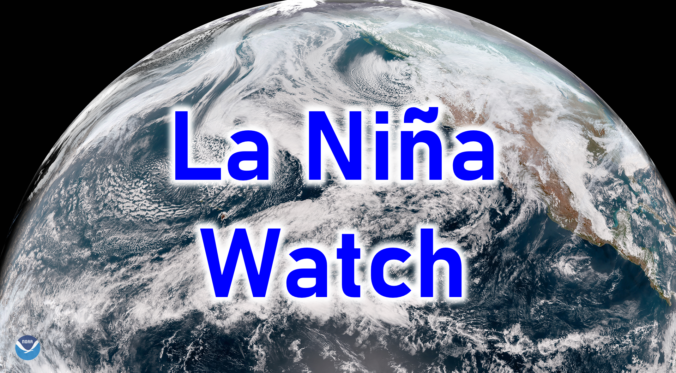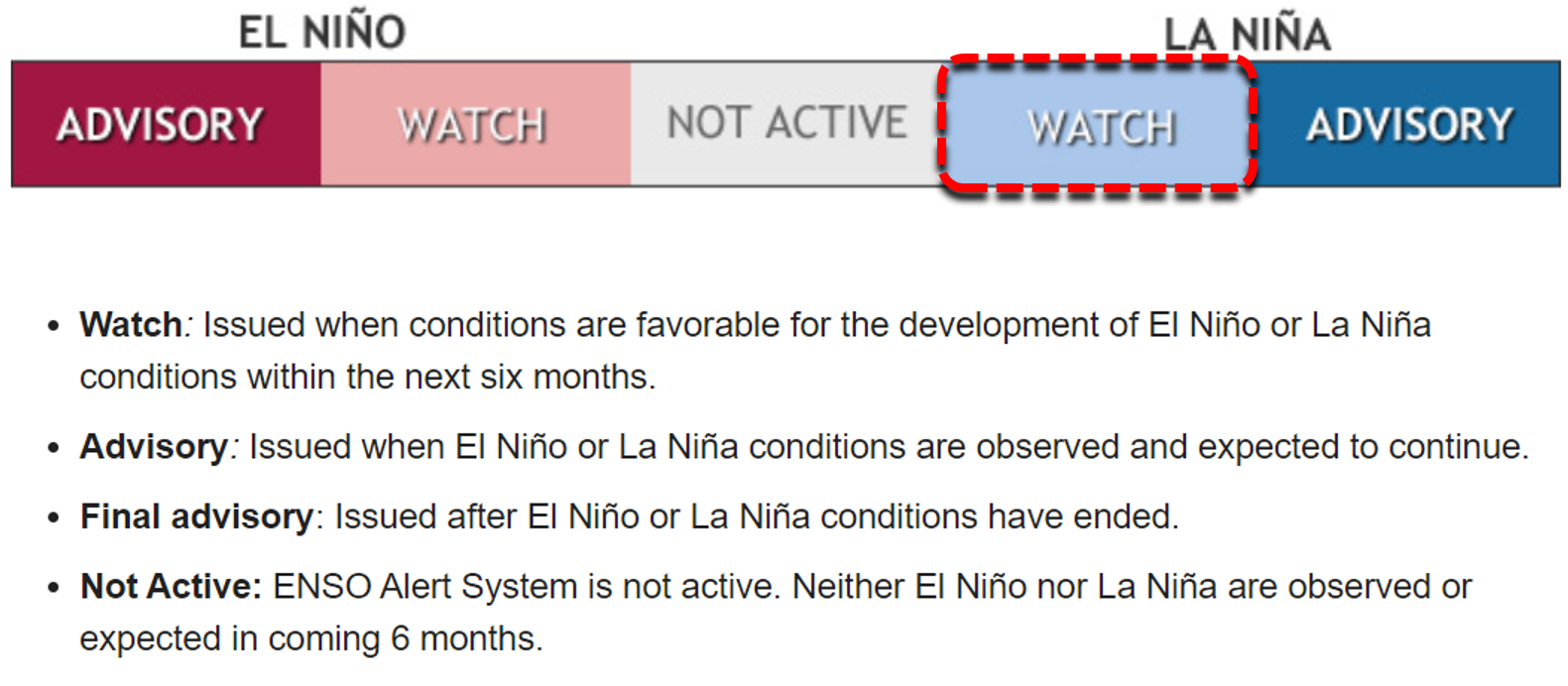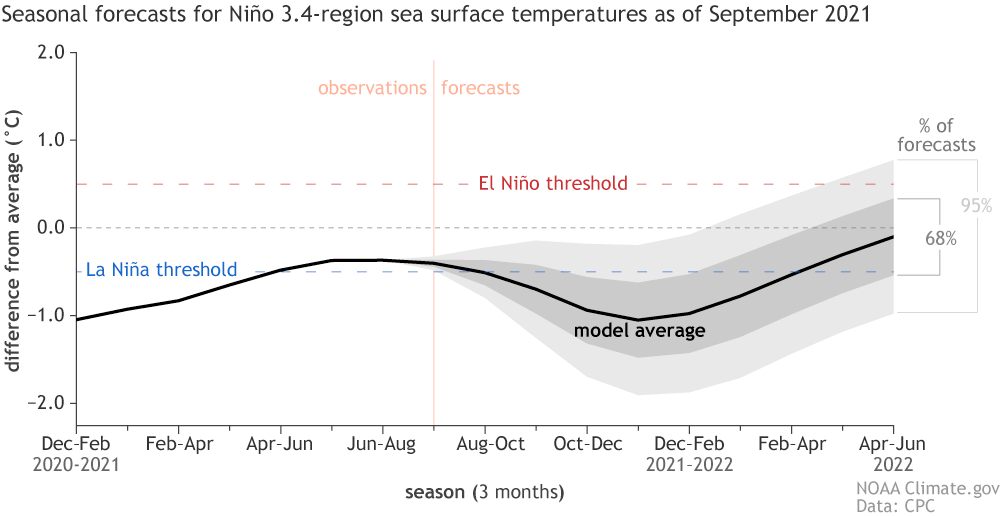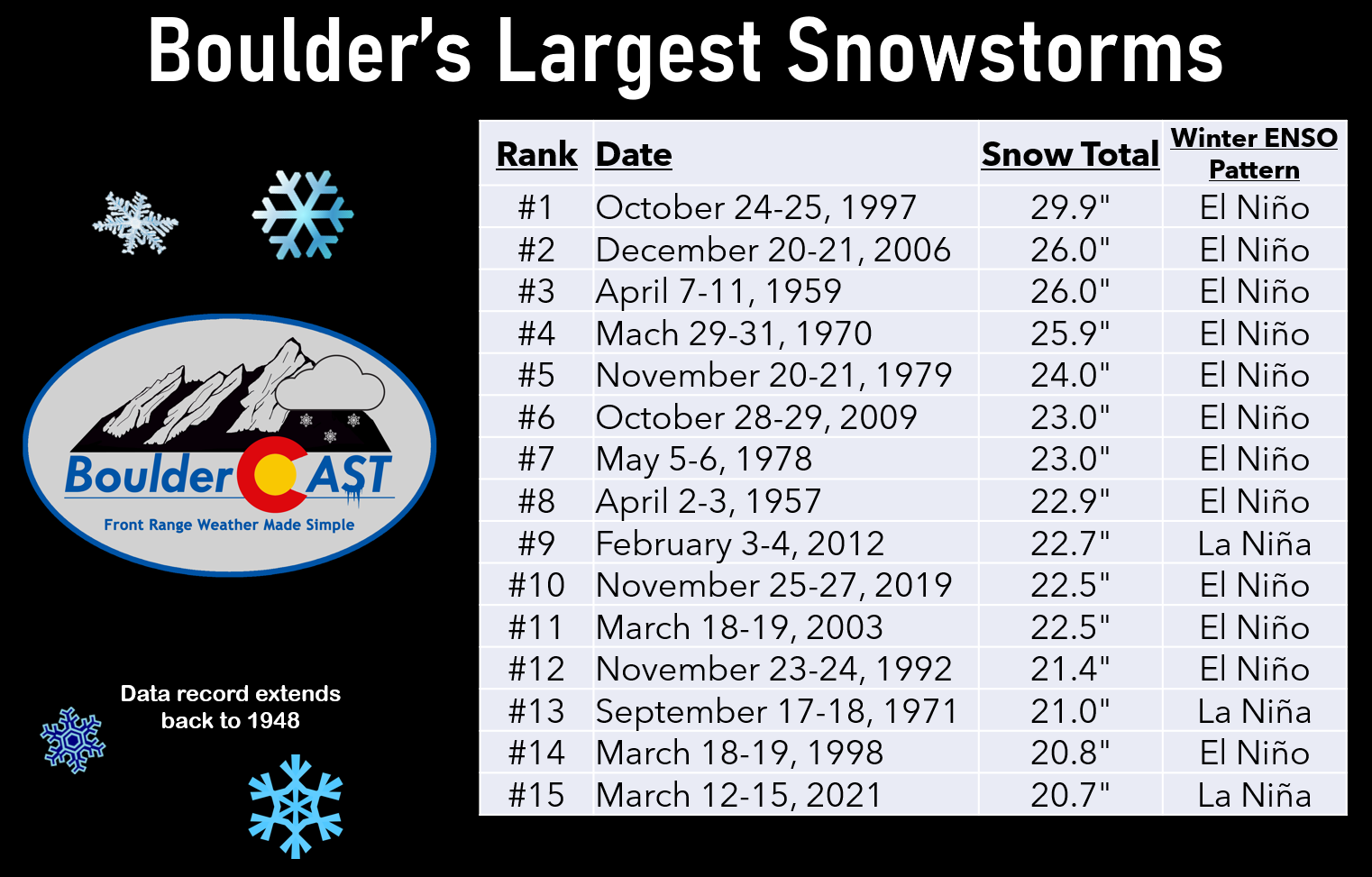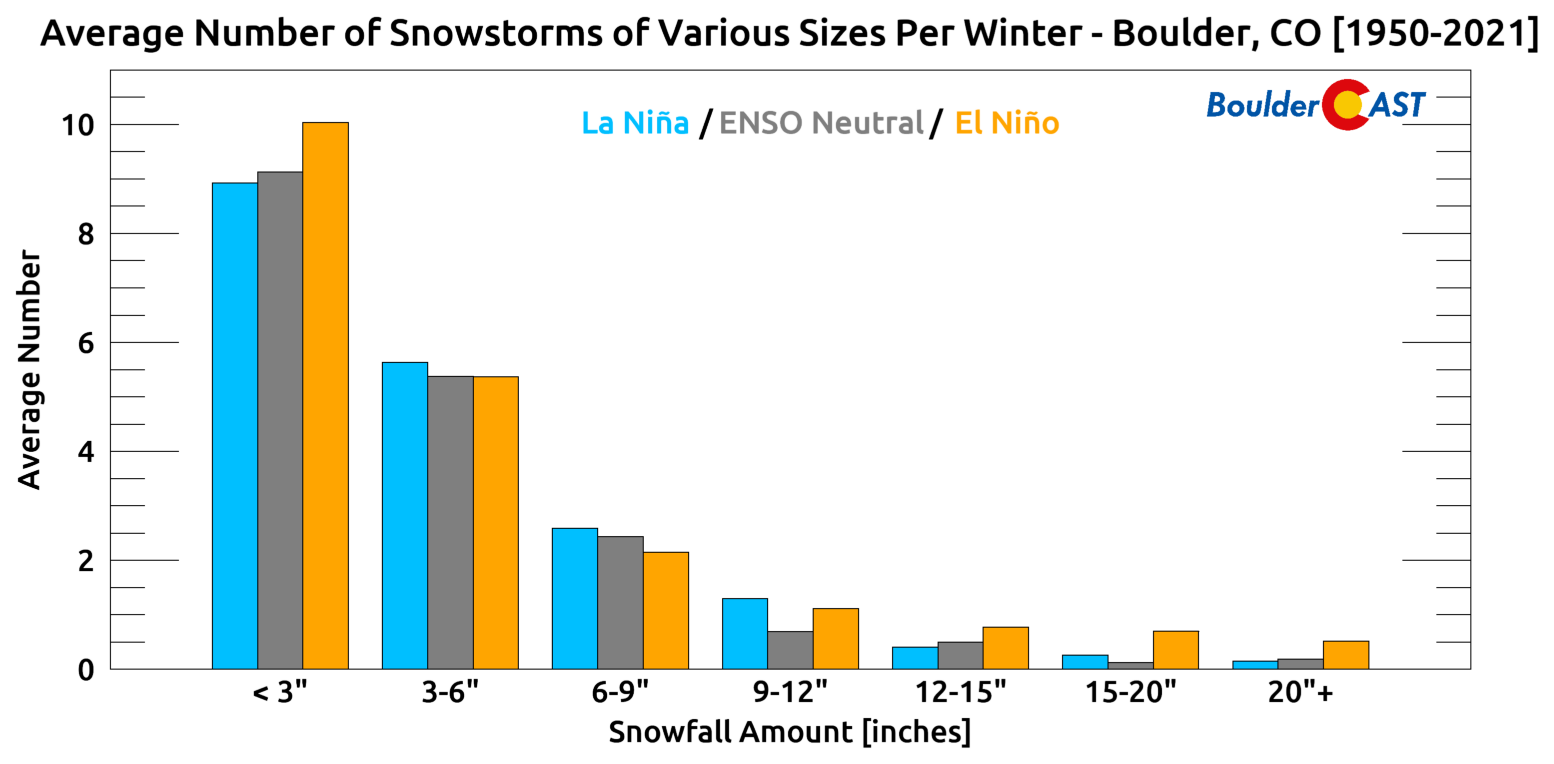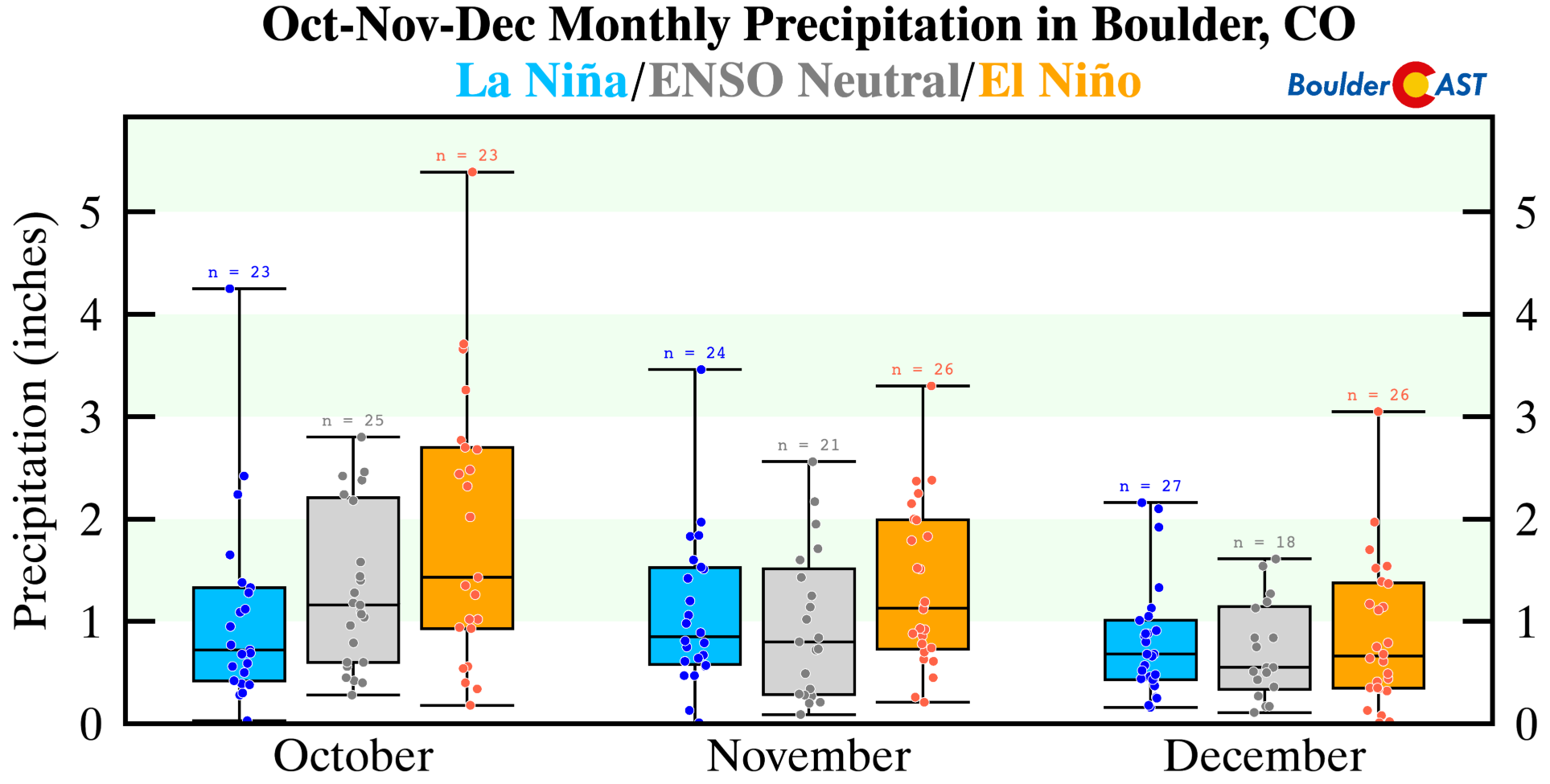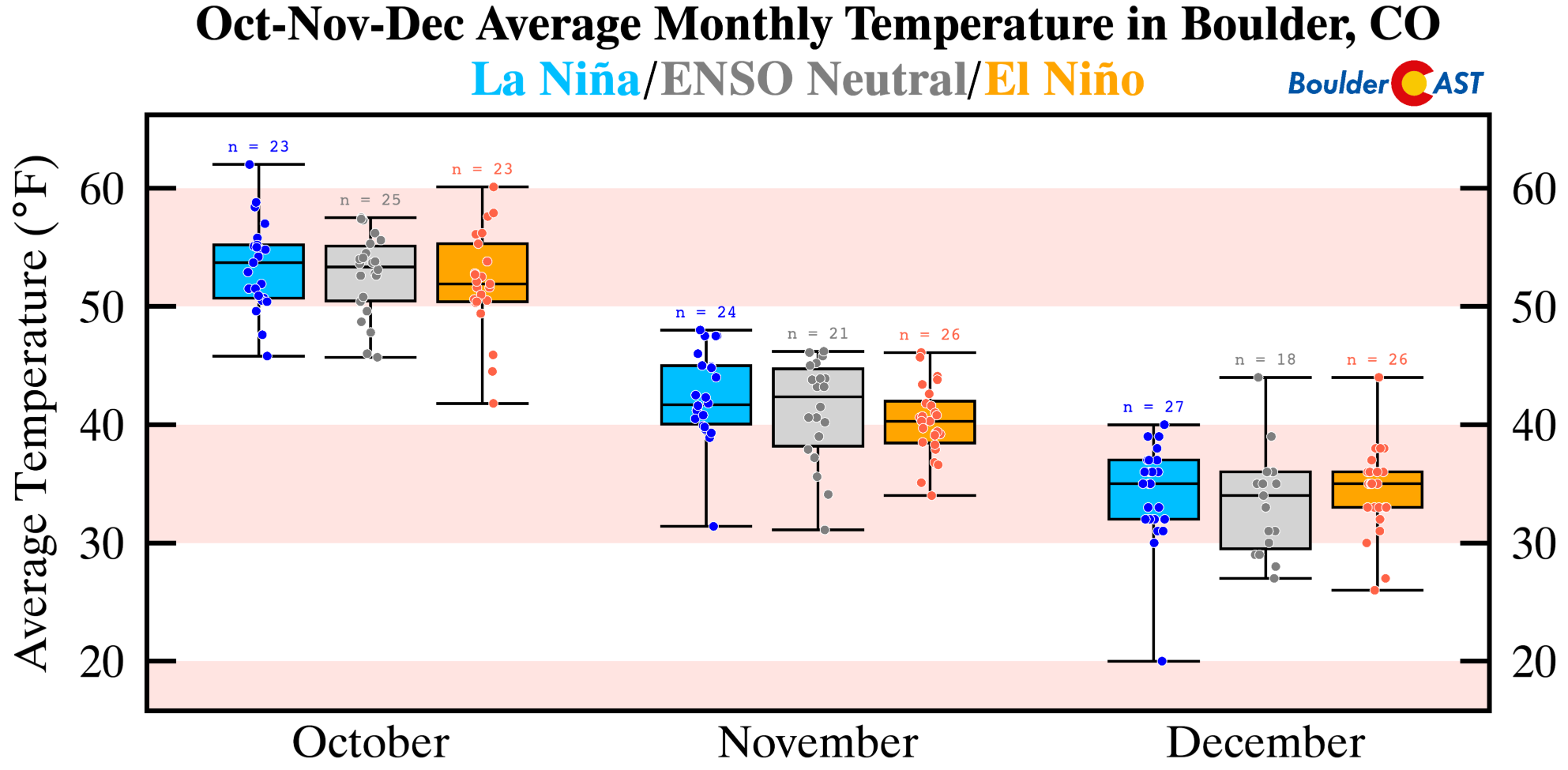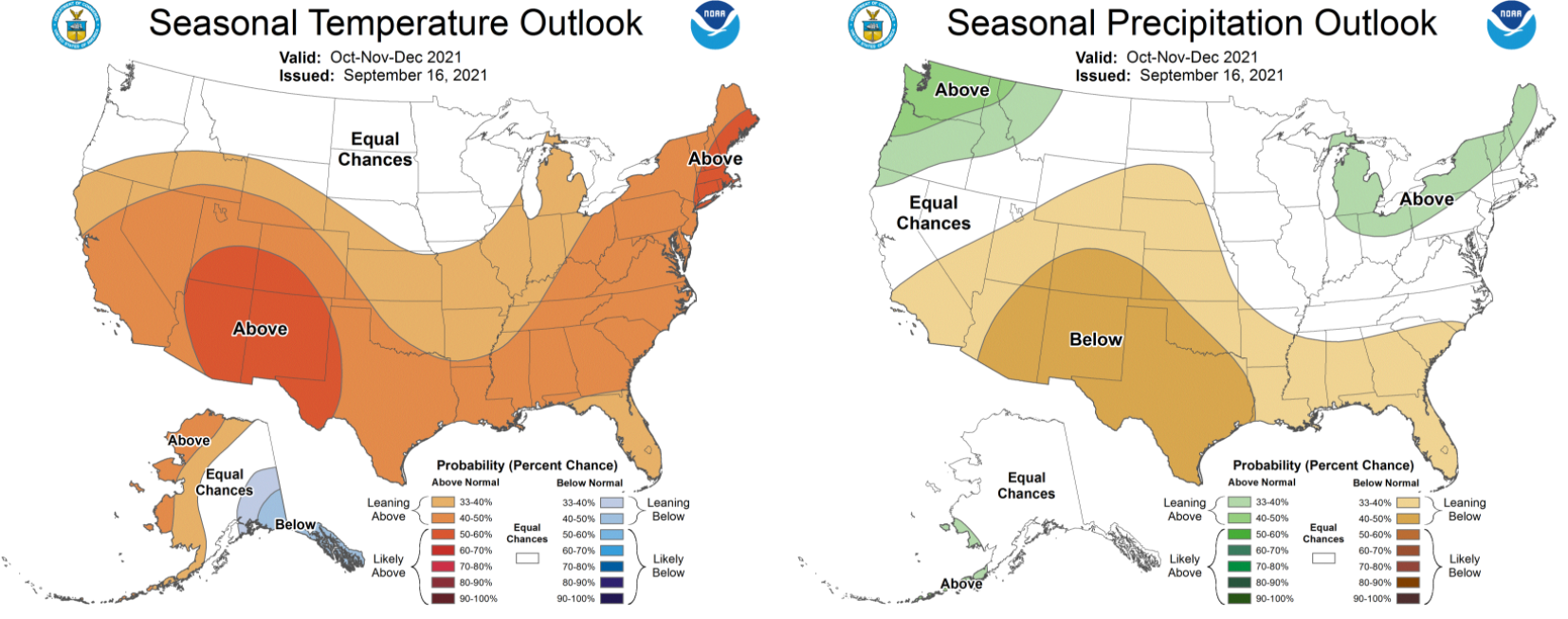For the second year in a row, La Niña conditions are expected to develop and last through the upcoming winter. We discuss the forecast, remind you what La Niña actually is, go over recent La Niña outcomes and explain the potential impacts this will have on Colorado for the rest of autumn.
We discuss Boulder and Denver weather every single day on BoulderCAST Premium. Sign up today to get access to our daily forecast discussions every morning, complete six-day skiing and hiking forecasts powered by machine learning, access to all our Front Range specific weather models, additional storm updates and much more!
Key Highlights from This Post:
- La Niña conditions are favored to develop very soon in the tropical Pacific Ocean and are expected to linger through the upcoming winter
- For the rest of 2021, we expect in general above normal temperatures and below normal precipitation
- Due to La Niña, we anticipate little to no “big” snow storms through the entire winter, but not necessarily less overall snow
- La Niña does correlate with more cold snaps, more freezing drizzle and more downslope wind events in the Front Range
A La Niña Watch has been issued
Climatologists have been predicting a return to La Niña for the 2021-2022 winter season for many months now, and that forecast remains on-track. As of writing in mid-October, we’re still technically seeing ENSO Neutral conditions across the tropical Pacific Ocean, but things are right on the brink of La Niña taking over. A La Niña Watch remains in effect.
Climatologists are projecting ~80% odds that La Niña will stick around through the autumn and upcoming winter seasons. The remaining 20% odds go towards an ENSO-Neutral winter, leaving no chances for our beloved El Niño! La Niña is favored to persist through February before things could return once again to ENSO Neutral.
The graphic below characterizes the ENSO forecasts from a smattering of climate models. A weak La Niña is the most likely outcome, though a moderate one is also possible as well.
What is La Niña?
Just in case you forget or need a reminder, La Niña is associated with cooler than normal ocean temperatures in the central and eastern tropical Pacific Ocean, with enhanced easterly trade winds along the Equator and a shift of the warmest waters westward in the Pacific towards Polynesia.
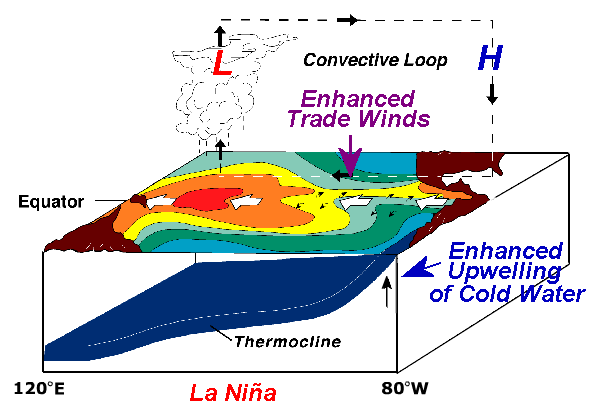
Large-scale upward motion in the atmosphere and the resulting thunderstorm development along the Equator follows the warm pool of ocean water westward. This creates a convective loop across the expansive Pacific Ocean from west to east (shown above). These are just the localized effects of La Niña. Our atmosphere and ocean are intimately coupled on a global scale. As such, locations all around the world, including Colorado, are influenced by ENSO. This is the topic of today’s discussion!
Tracking La Niña
To keep eyes on ENSO, researchers have deployed large arrays of buoys throughout the Pacific to monitor ocean temperatures at the surface and deep below. The most widely accepted/correlated temperature measurements come out of a region known as Niño 3.4 (shown below). From these measurements, the Oceanic Niño Index (ONI) is used to determine the current state of ENSO, with an ONI > 0.45 indicating an El Niño (which is a warm anomaly), an ONI < -0.45 categorized as La Niña (which is a cold anomaly), and an ONI in between labeled as ENSO-Neutral.

The 3.4 Niño region in the Pacific Ocean. This area is heavily monitored by humanity in order to keep tabs on ENSO
Scientists have been tracking the ONI since the mid-20th century. The table below shows three-month running average ONI values over the last 20 or so years. Three of the last five winters have been La Niñas, including the most recent winter.
As of October 11 2021, the normalized temperature anomaly in Niño 3.4 is -0.6°C with the latest ONI being -0.5°C (representing the average of July through September). As mentioned earlier, this is right on the very cusp of being classified as La Niña.
A look at the latest high-resolution sea surface temperature anomalies shows a clear La Niña-like pattern along the Equator in the Pacific.
Waters are forecast to continue to cool in the eastern tropical Pacific Ocean with La Niña taking over soon. The graphs below of temperature anomalies show the expansion of the cool water below the ocean’s surface since mid-August. Essentially this is a time-lapse of La Niña being born once again!
The main take-away here is that La Niña is on the way and likely to stay for the autumn and winter seasons ahead! Let’s take a look at the expected impacts on our weather.
What does this all mean for Front Range Colorado this winter?
The (admittedly oversimplified) diagram below shows the general winter conditions during the positive and negative phases of ENSO across North America. A “typical” La Niña winter sees the jet stream keep a more northwesterly orientation across Colorado (top diagram below). Most of our storms will therefore be the cold and relatively dry Canadian variety. This is opposed to the juicy and comparatively warm storms that are a staple of El Niño winters for the Front Range. This jet position during La Niña also produces more orographic snows for the Mountains favored by northwest flow (those near Steamboat, plus Winter Park).

Another consequence of this jet pattern is the potential for more frequent Arctic outbreaks across the central United States and also the Denver Metro area on occasion. Some of these outbreaks can be accompanied by freezing fog and freezing drizzle under the right circumstances. This is exactly what unfolded during the La Niña winter three years ago. At times, it seemed like we couldn’t go a single week without a freezing drizzle event. Trust us, as weather forecasters this shift away from snow and towards freezing drizzle got annoying quickly. That’s without even considering the constant struggle of chiseling ice off the windshield that winter!
The last three La Niña snow seasons (2016-17 , 2017-18 & 2020-21) combined had only three snowstorms that produced more than 9″ of snow in Boulder. Let that sink in for a moment! Just a total of three 9-inchers in three entire winters! To put this into perspective, the most recent two El Niño seasons (2018-19 & 2019-20) had five storms that dumped more than 14″ of snow in Boulder. This is no surprise though. Big snow storms are indeed less frequent for us during La Niña years, and by quite a large margin. Over the last 70+ years, only 6 out of 36 snowstorms (17%) dropping at least 15 inches in the city of Boulder occurred during La Niña conditions, relative to neutral or El Niño patterns. The pie graphs below show just how skewed our biggest snowstorm climatology is towards El Niño and away from La Niña. Not good news if you enjoy crippling snowstorms and the like.
However, as we saw back in March of 2021, epic snowstorms are certainly still possible during La Niña, they are just much less likely. Only 3 of the top 15 biggest snowstorms in Boulder’s history occurred during a winter where La Niña was present.
We do want to reiterate that long-term there is no correlation between ENSO and total seasonal snowfall in the Front Range Mountains or Plains. The less frequent big dumpings of El Niño are replaced with relatively more frequent smaller snow events during La Niña (see the graphic below). These opposing paths to snow accumulation more-or-less balance each other out across our area. So we’re not totally hosed for precipitation and snow this winter. Not yet at least!
Our perceived thoughts on weather conditions surrounding La Niña are indeed backed up by the data. Based on temperature and precipitation analysis from the Climate Prediction Center, the autumn period (OCT/NOV/DEC ) under La Niña has a clear warm and dry theme for all of northeast Colorado (Climate Division #46).The graphs below are called box-and-whisker plots. The red lines indicate the median value….the blue boxes contain 50% of all years….while the “whiskers” fan out to the more extreme years.
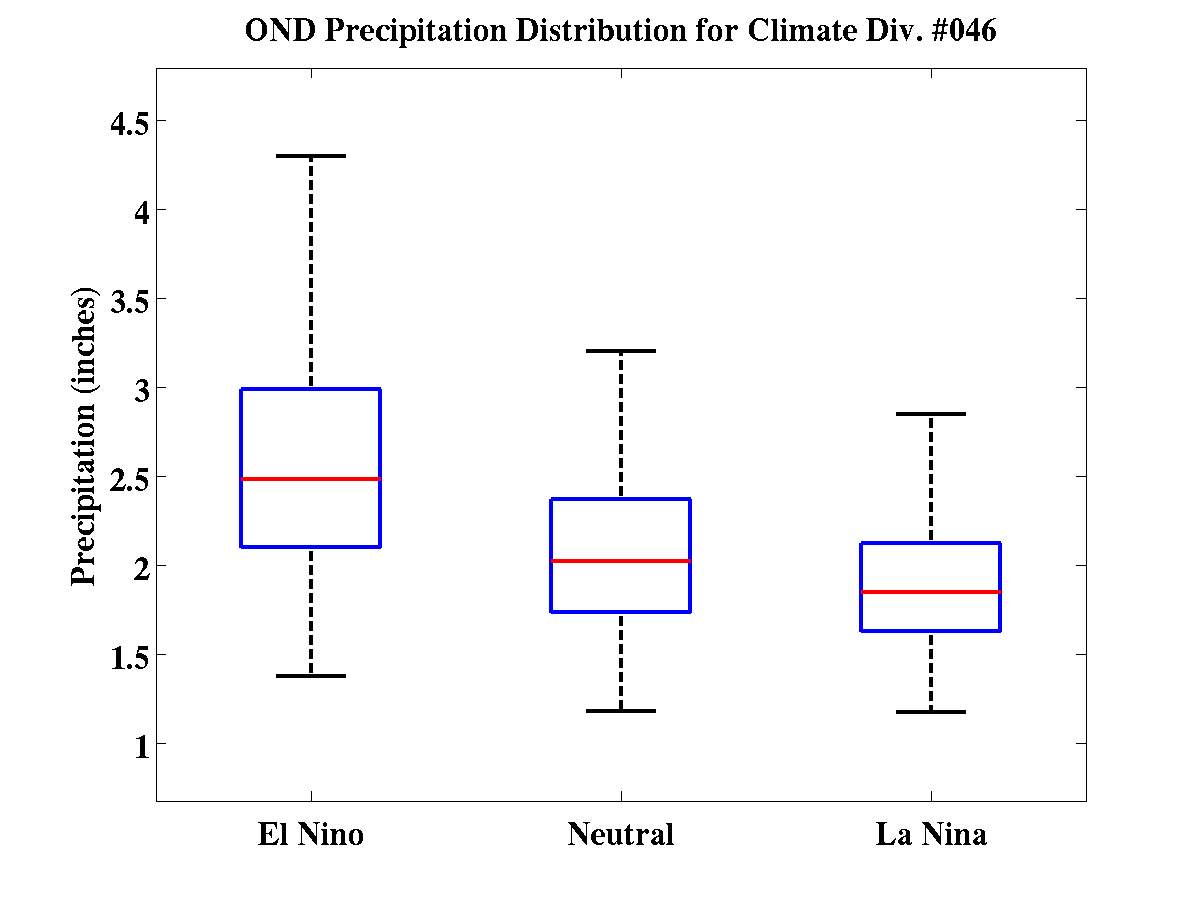
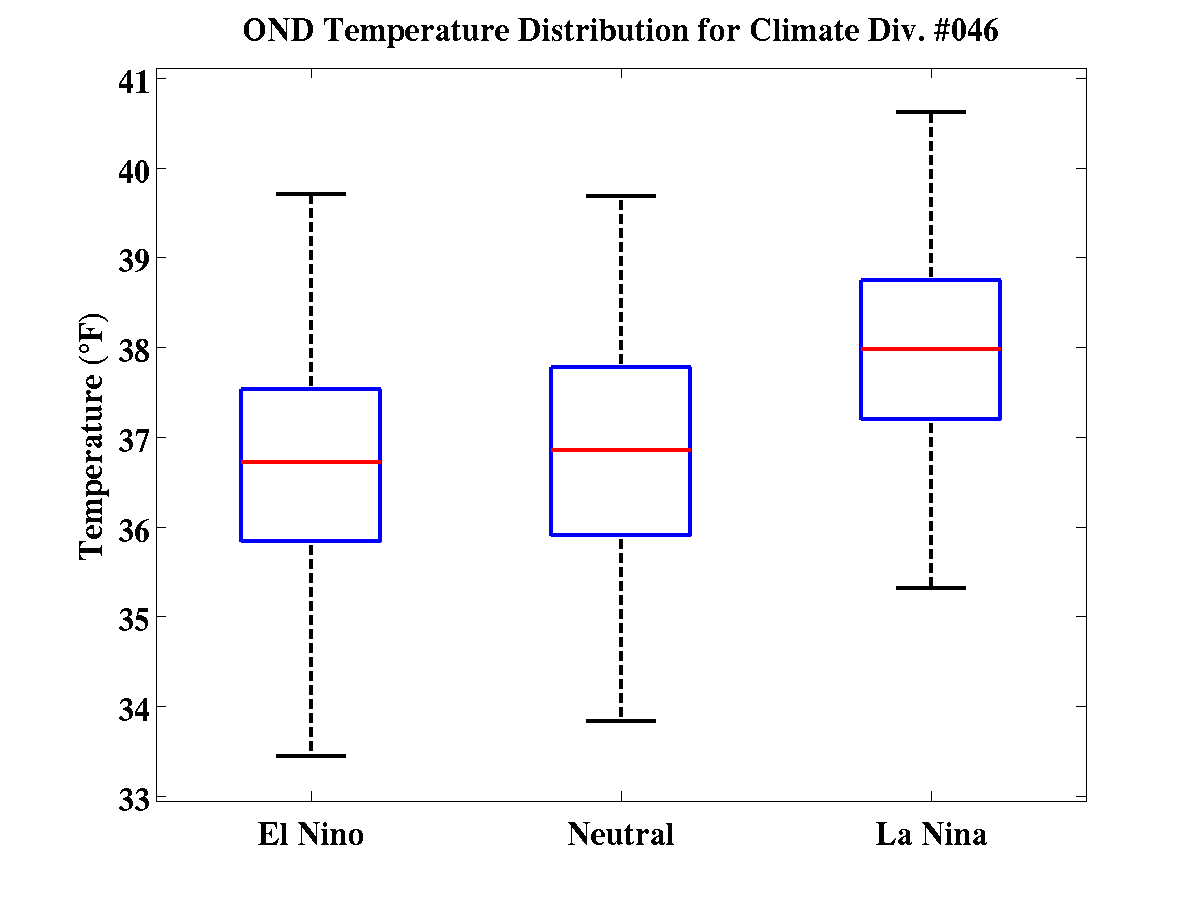
La Niña autumns definitely trend warmer and drier for northeast Colorado relative to average. Furthermore, precipitation variability compared to neutral autumns, and certainly El Niño autumns, is greatly reduced. This is seen by a shorter “whisker” length in the La Niña precipitation graphic and is largely due to the lack of intense southern storms that tap into Gulf of Mexico moisture. These big events tend to make-or-break El Niño winters and can be highly variable, especially in autumn.
We repeated the same analysis as above, but only for the city of Boulder. The data is very similar with a generally dry and warm trend observed during La Niña autumns in Boulder, too. Precipitation is particularly reduced in the month of October during La Niña . This dry signal is not significant in November or December, at least in Boulder.
In respect to temperatures, both the mean and median values in Boulder are higher during La Niñas for all three months, so at least on paper we have a good chance at a warm fall this year. Interestingly, we start to see the bottom “whisker” of La Niña temperatures extend quite far downward in November and especially December. This is a signal of the Arctic outbreaks we alluded to earlier that generate little in the way of snowfall, but may produce freezing drizzle across the Front Range and in Boulder. These bitter cold snaps become more common during the heart of winter into early spring. Autumn is not prime-time for cold air outbreaks, but it can happen of course.
What about the snowfall outlook? Well, both Boulder and Denver received above normal snowfall last year which was also a La Niña pattern. However, a significant portion of the season’s snow came in the single monster March snowstorm (20% in Boulder, 35% in Denver). Out of all three ENSO phases, La Niña consistently produces the least snowfall during October and November in Boulder. December is more variable, but the median snowfall is still lowest during La Niña. All in all, we should expect lower snowfall than normal these next few months.
The temperature and precipitation seasonal outlook from the Climate Prediction Center for October through December is shown below. Their outlook is right in-line with of our thinking for Colorado, one we have touched on already. That is, increased chances for a warmer and drier than normal conclusion to 2021.
Given the outlook, drought conditions will likely intensify further across Colorado, while some reprieve seems possible this fall for the Pacific Northwest and far northern Rockies.
Colorado’s fate isn’t 100% sealed, though. ENSO just gives us an idea towards the most likely conditions to occur during the fall and winter. The “randomness” of Earth’s complicated weather patterns from year-to-year is much more dominant on our weather than ENSO could ever be. We do note that some of the wettest/snowiest autumn months in Boulder’s history have occurred during La Niñas (November 1983 & October 1984), so it’s not impossible that we squeak out some beneficial precipitation before the end of the year. It’s just not very likely.
Help support our team of Front Range weather bloggers by joining BoulderCAST Premium. We talk Boulder and Denver weather every single day. Sign up now to get access to our daily forecast discussions each morning, complete six-day skiing and hiking forecasts powered by machine learning, first-class access to all our Colorado-centric high-resolution weather graphics, bonus storm updates and much more! Or not, we just appreciate your readership!
.
Enjoy this content? Do us a favor and give it a share!
.

